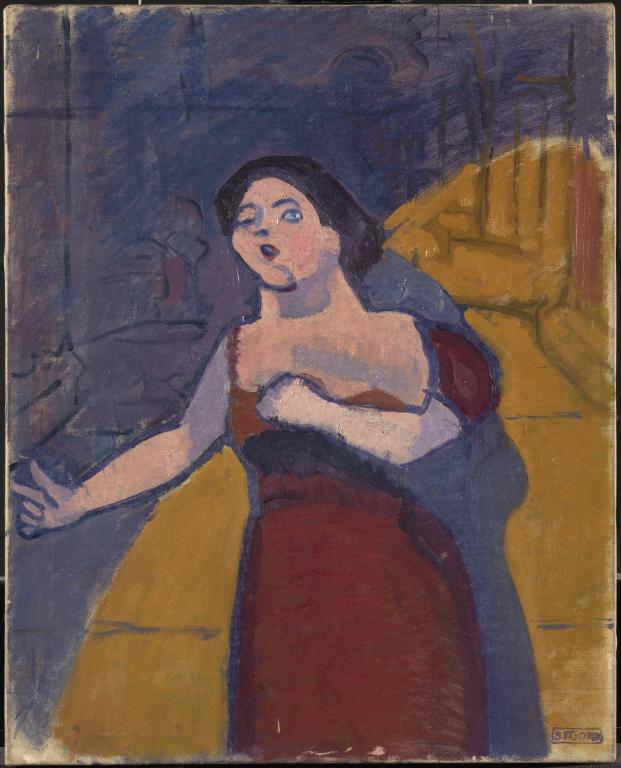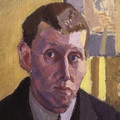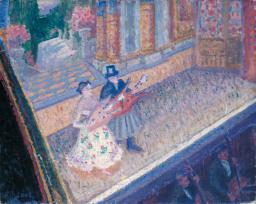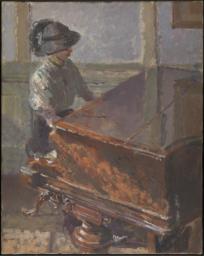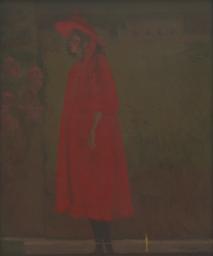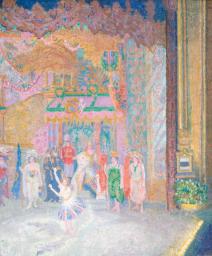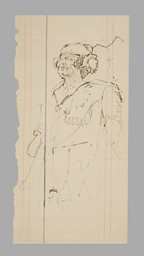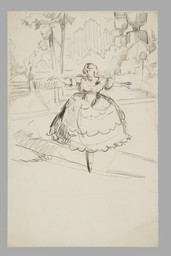Spencer Gore A Singer at the Bedford Music Hall 1912
Spencer Gore,
A Singer at the Bedford Music Hall
1912
Gore’s painting shows a performance at the Bedford Music Hall on Camden High Street by the singer Florrie Forde. Her figure is treated in a simplified manner, with her dark shadow interrupting the circle of the spotlight cast on the flat scenery behind. Gore lived nearby and liked to sketch at the New Bedford, perhaps sometimes in the company of Walter Sickert, who also made pictures of its neo-baroque interior.
Spencer Gore 1878–1914
A Singer at the Bedford Music Hall
1912
Oil paint on canvas
533 x 432 mm
Inscribed by Harold Gilman ‘Painted by S.F. Gore in 1912. It is painted | from one drawing done in the Bedford music | Hall. | (a) (147)’ in ink on label on canvas stretcher; ‘147 59 113’ in white chalk on back; studio stamp ‘S.F. GORE’ bottom right.
Presented by Mr and Mrs Robert Lewin through the Friends of the Tate Gallery 1978
T02260
1912
Oil paint on canvas
533 x 432 mm
Inscribed by Harold Gilman ‘Painted by S.F. Gore in 1912. It is painted | from one drawing done in the Bedford music | Hall. | (a) (147)’ in ink on label on canvas stretcher; ‘147 59 113’ in white chalk on back; studio stamp ‘S.F. GORE’ bottom right.
Presented by Mr and Mrs Robert Lewin through the Friends of the Tate Gallery 1978
T02260
Ownership history
Mrs Mary Johanna Gore, the artist’s widow; bought at Redfern Gallery, London, 1962 by Armand Hammer (1898–1990); ... ; untraced sale, Parke Bernet, New York, late 1960s, bought by Mr and Mrs Robert Lewin; presented by Mr and Mrs Lewin through the Friends of the Tate Gallery 1978.
Exhibition history
1962
Spencer Gore and Frederick Gore, Redfern Gallery, London, February–March 1962 (59, as ‘At the Bedford Music-hall’).
1970
Spencer Gore 1878–1914, The Minories, Colchester, March–April 1970, Ashmolean Museum, Oxford, April 1970, Graves Art Gallery, Sheffield, May–June 1970 (51).
References
1979
Wendy Baron, The Camden Town Group, London 1979, pp.240, 374.
1979
Tate Gallery Acquisitions 1976–78, London 1979, pp.73–4, reproduced p.73.
1985
Richard Cork, Art Beyond the Gallery in Early 20th Century England, New Haven and London 1985, p.69, reproduced fig.89.
2000
Wendy Baron, Perfect Moderns: A History of the Camden Town Group, Aldershot and Vermont 2000, pp.126, 181.
Technique and condition
A Singer at the Bedford Music Hall is painted on stretched primed canvas. The cloth is linen with a simple twill weave that produces a pattern of diagonal ribs. It has been prepared with glue size, most of which seems to have been absorbed into the cloth, and a dense white priming composed mostly of lead white but with some chalk and/or gypsum, probably bound in oil. Priming extends to the cut edges of the canvas and conforms to the weave texture.
Faint traces of squaring-up used to transfer the image from a drawing are visible at the edges, where the paint has been thinly applied. The outline of the composition was then roughed in using thinned dark blue underpaint, deliberately left visible in areas. This technique is common to nearly all of Gore’s works in the Tate collection and seems to be a standard part of his practice.1 Drawing in thinned blue and sometimes black paint was a distinctive feature of post-impressionist painting, which was recognised at the time and has since been emphasised in technical studies.2 It has also been identified in the work of Robert Bevan and Charles Ginner (see Tate N05911, N04750, T00282), but is largely absent in that of Harold Gilman and Walter Sickert, who were critical of the practice.3
The painting was swiftly executed, leaving exposed areas of priming notably towards the edges. The contrasting areas of stage and backdrop created by the spotlight are broadly laid in using a stiff brush and thin blue, purple and greenish yellow paints. The way in which the paint is lifted from the brush by the canvas emphasises the diagonal texture of the canvas weave. Areas of blue drawing were then reinstated and modified while still wet, picking up and mixing adjacent areas of colour, as where the yellow is dragged through the blue towards the top right. These areas were reinforced and modified with brighter opaque lilac and yellow paints to refine the colour and define the strong form of the singer and her shadow. Equally they are vigorously executed with more intricate and dense layering of predominantly slick opaque colours applied wet-in-wet. As in the background, outlines of the figure are retained and reinstated. Modifications, such as the repositioning of the left arm and right hand gesture, were made quickly allowing the flesh and blue colours to mix. The painting is unvarnished.
Roy Perry and Sarah Morgan
July 2004
Notes
How to cite
Roy Perry and Sarah Morgan, 'Technique and Condition', July 2004, in Robert Upstone, ‘A Singer at the Bedford Music Hall 1912 by Spencer Gore’, catalogue entry, May 2009, in Helena Bonett, Ysanne Holt, Jennifer Mundy (eds.), The Camden Town Group in Context, Tate Research Publication, May 2012, https://wwwEntry
A label on the stretcher is inscribed in ink by Harold Gilman: ‘Painted by S.F. Gore in 1912. It is painted | from one drawing done in the Bedford music | Hall. | (a) (147)’. The reverse of the canvas has been inscribed in white chalk ‘147 59 113’, which, because of its first number, is probably by Gilman too. After Gore’s death, Gilman went through his studio and numbered the canvases on their reverse in what he believed was their order of execution, adding ‘(a)’ to those he believed to be of special interest or value.
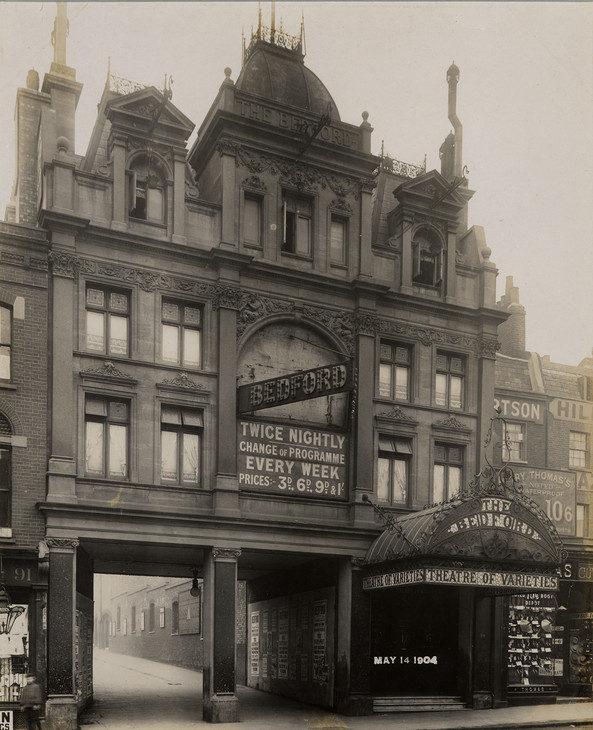
Ernest Milner 1862–1933
London Transport photograph of 91–97 Camden High Street, with the Bedford Theatre of Varieties 14 May 1904
278 x 227 mm
Camden Local Studies and Archives Centre
Photo © Camden Local Studies and Archives Centre
Fig.1
Ernest Milner
London Transport photograph of 91–97 Camden High Street, with the Bedford Theatre of Varieties 14 May 1904
Camden Local Studies and Archives Centre
Photo © Camden Local Studies and Archives Centre
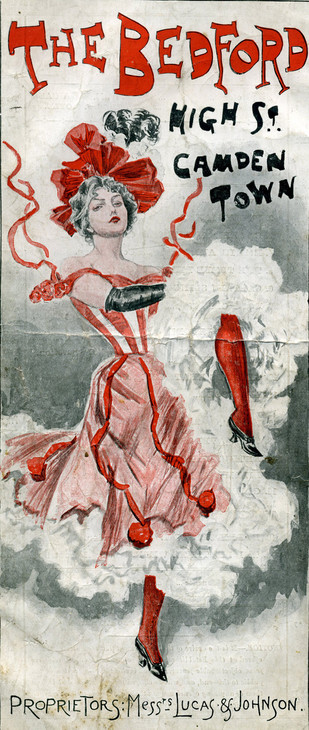
The Bedford Music Hall programme Monday 2 October 1899
Paper print
The Mander and Mitchenson Theatre Collection
Photo © The Mander and Mitchenson Theatre Collection / ArenaPal
Fig.2
The Bedford Music Hall programme Monday 2 October 1899
The Mander and Mitchenson Theatre Collection
Photo © The Mander and Mitchenson Theatre Collection / ArenaPal
The Bedford Music Hall was at 93–95 Camden High Street, just a few minutes’ walk from Gore’s flat in Houghton Place (figs.1 and 2).1 The original Bedford Music Hall opened in 1861, but burnt down in 1896. A very popular venue, it was rebuilt and opened as the Beford Palace of Varieties on 6 February 1899. The interior was designed in an ebullient neo-baroque style, opulently gilded, and decorated with plaster caryatids and putti and red velvet hangings. It could hold 1,100 people.2 The theatre attracted some of the most famous music-hall artists of the day, including Marie Lloyd, Little Tich and Charles Coburn, with his famous songs The Man Who Broke the Bank at Monte Carlo and Two Lovely Black Eyes . In 1912 both the actor Charlie Chaplin and singer Gracie Fields appeared there.3
Marie Lloyd (1870–1922) performs 'The Coster Girl in Paris' (recorded July 1912)
© Windyridge Music Hall CDs
Little Tich (1867–1928) performs 'There's a Silly Thing to Ask a Policeman' (recorded January 1915)
© Windyridge Music Hall CDs
Little Tich (1867–1928) performs 'The Zoo Keeper' (recorded August 1911)
© Windyridge Music Hall CDs
Music halls were still extremely popular, but were facing competition from other sources of mass entertainment, notably the new phenomenon of the picture palace. Music halls were expensive and therefore sometimes risky businesses to run. In 1911 there was a meeting of the creditors of Benjamin Pearce Lucas of 80 Arlington Road, Regent’s Park, the one-time owner of the Bedford. It was reported in the Times that:
the debtor had stated that he was acting as manager and director of the Bedford Music Hall, which he acquired about May, 1898, and rebuilt. In February, 1899, he reopened the hall, and carried it on for two years at a loss. Six months later he sold it to the Bedford Palace of Varieties (Limited), of which he was appointed managing director. The business was successfully conducted until three years ago, but no profit had since been made owing to competition ... The failure was attributed to losses in connexion with music-halls; the competition of picture palaces; heavy expenses and payments to artists ... The meeting resolved that the debtor should be adjudged bankrupt.4
In 1908 Lucas had tried to block the opening of the grand Camden Town Palace at Mornington Crescent. He lodged a complaint at the licence hearing that ‘the locality was already amply provided with music halls ... and ... that the setting up of this new music hall would be unfair trade competition and that it was not needed in the neighbourhood’.5 The London County Council granted the Palace its licence ‘on condition that no intoxicating liquor was sold or consumed on the premises’.6
Sickert had painted the original ‘Old Bedford’ theatre and, from 1908, he made a series of pictures of the rebuilt music-hall interior and its audience, including The New Bedford (Tate N06174). Gore made his earliest known picture of the Bedford in 1907,7 which depicts a singer on the stage treated in a similarly simplified manner to the Tate picture. It is tempting to speculate whether Gore and Sickert attended performances there together around 1907–8.
In A Singer at the Bedford Music Hall the figure has a strangely contorted facial expression. This may be because she is winking at the audience, perhaps during the kind of song that contained the double entendres which were so popular in the music halls of the period. The stylisation of the figure would appear to derive from the post-impressionist Paul Gauguin, although the commitment to a theatrical subject is entirely characteristic of Gore.
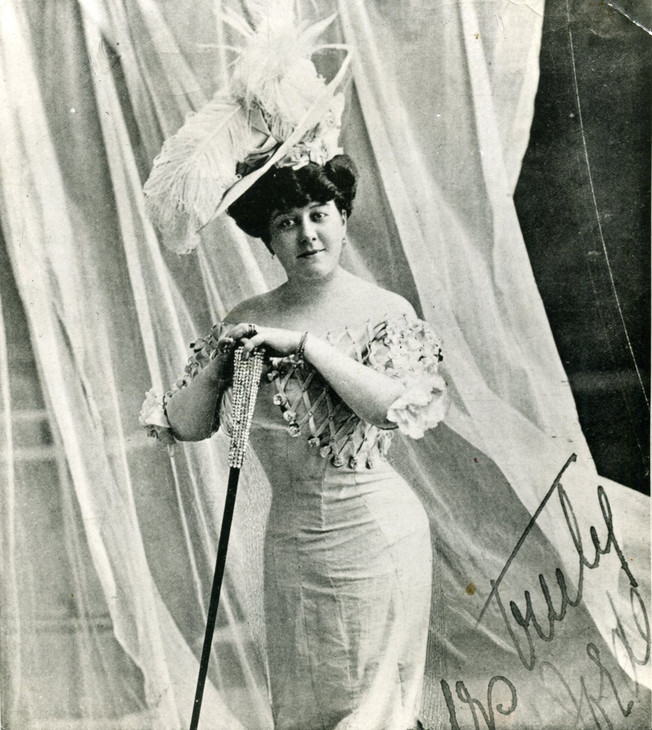
Florrie Forde
Photographic print
The Mander and Mitchenson Theatre Collection
Photo © The Mander and Mitchenson Theatre Collection / ArenaPal
Fig.3
Florrie Forde
The Mander and Mitchenson Theatre Collection
Photo © The Mander and Mitchenson Theatre Collection / ArenaPal
Alice Lloyd (1873–1949) performs 'The Nearer the Bone, The Sweeter the Meat'
© Windyridge Music Hall CDs
The singer has been identified by Max Tyler, the Historian of the British Music Hall Society, as Florrie Forde (1876–1940, fig.3).8 Born in Melbourne, Forde was an immensely popular and successful performer who debuted on the London stage in 1897. She was known for ‘chorus songs’, that is songs where she would invite the audience to sing along with her during the chorus. Among Forde’s most famous songs were Hold Your Hand out Naughty Boy, Down at the Old Bull and Bush, Has Anyone Here Seen Kelly and Oh Oh Antonio. During the First World War she entertained the troops and theatres with It’s a Long Way to Tipperary, Take Me Back to Dear Old Blighty and Pack Up Your Troubles in Your Old Kit Bag. Forde introduced over six hundred songs in all, and most of these were published; the sale of the sheet music was extremely lucrative. She paid to secure sole theatre performance rights for many songs which became her trademarks.9
Robert Upstone
May 2009
Notes
Related biographies
Related essays
- Leisure Interiors in the Work of the Camden Town Group Jonathan Black, Fiona Fisher and Penny Sparke
- A History of Camden Town 1895–1914 David Hayes
Related catalogue entries
Related archive items
Related audio
-
Florrie Forde 1875–1940 performs 'Hold your Hand out you Naughty Boy' recorded April 1915© Windyridge Music Hall CDs
-
Florrie Forde 1875–1940 performs 'Has anyone here seen Kelly?' recorded July 1909© Windyridge Music Hall CDs
-
Florrie Forde (1875–1940) performs 'Pack up your Troubles in your Old Kit Bag' recorded August 1929© Windyridge Music Hall CDs
-
Florrie Forde 1875–1940 performs 'It's a Long Way to Tipperary' recorded August 1929© Windyridge Music Hall CDs
-
Little Tich 1867–1928 performs 'There's a Silly Thing to Ask a Policeman' recorded January 1915© Windyridge Music Hall CDs
-
Charles Coburn 1852–1945 performs 'Two Lovely Black Eyes' recorded September 1929© Windyridge Music Hall CDs
-
Charles Coburn 1852–1945 performs 'The Man who Broke the Bank' recorded 1929© Windyridge Music Hall CDs
-
Marie Lloyd 1870–1922 performs 'The Coster Girl in Paris' recorded July 1912© Windyridge Music Hall CDs
-
Little Tich 1867–1928 performs 'The Zoo Keeper' recorded August 1911© Windyridge Music Hall CDs
-
Florrie Forde 1875–1940 performs 'The Bull and Bush' recorded September 1904
-
Alice Lloyd 1873–1949 performs 'The Nearer the Bone, The Sweeter the Meat'© Windyridge Music Hall CDs
How to cite
Robert Upstone, ‘A Singer at the Bedford Music Hall 1912 by Spencer Gore’, catalogue entry, May 2009, in Helena Bonett, Ysanne Holt, Jennifer Mundy (eds.), The Camden Town Group in Context, Tate Research Publication, May 2012, https://www

